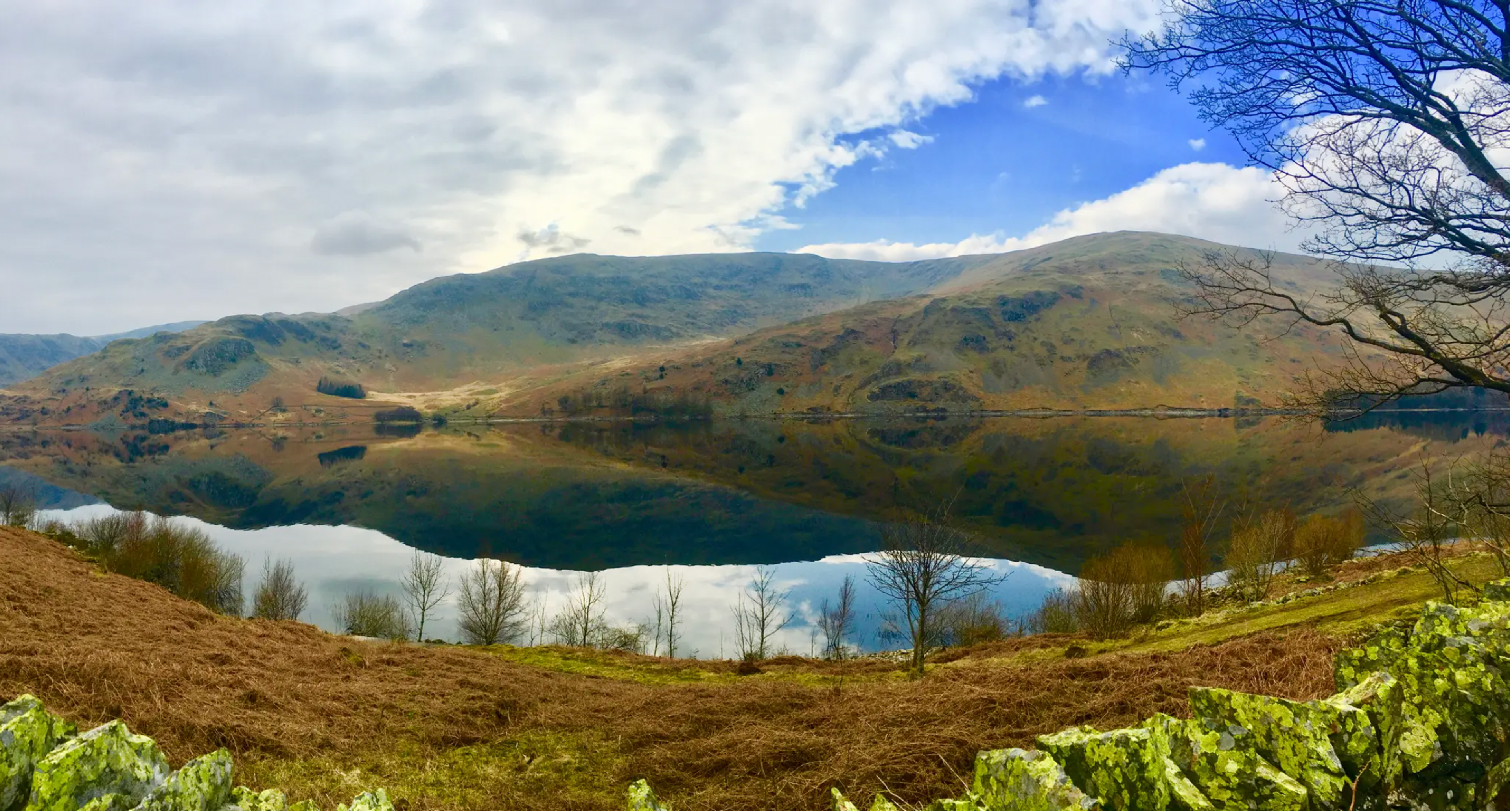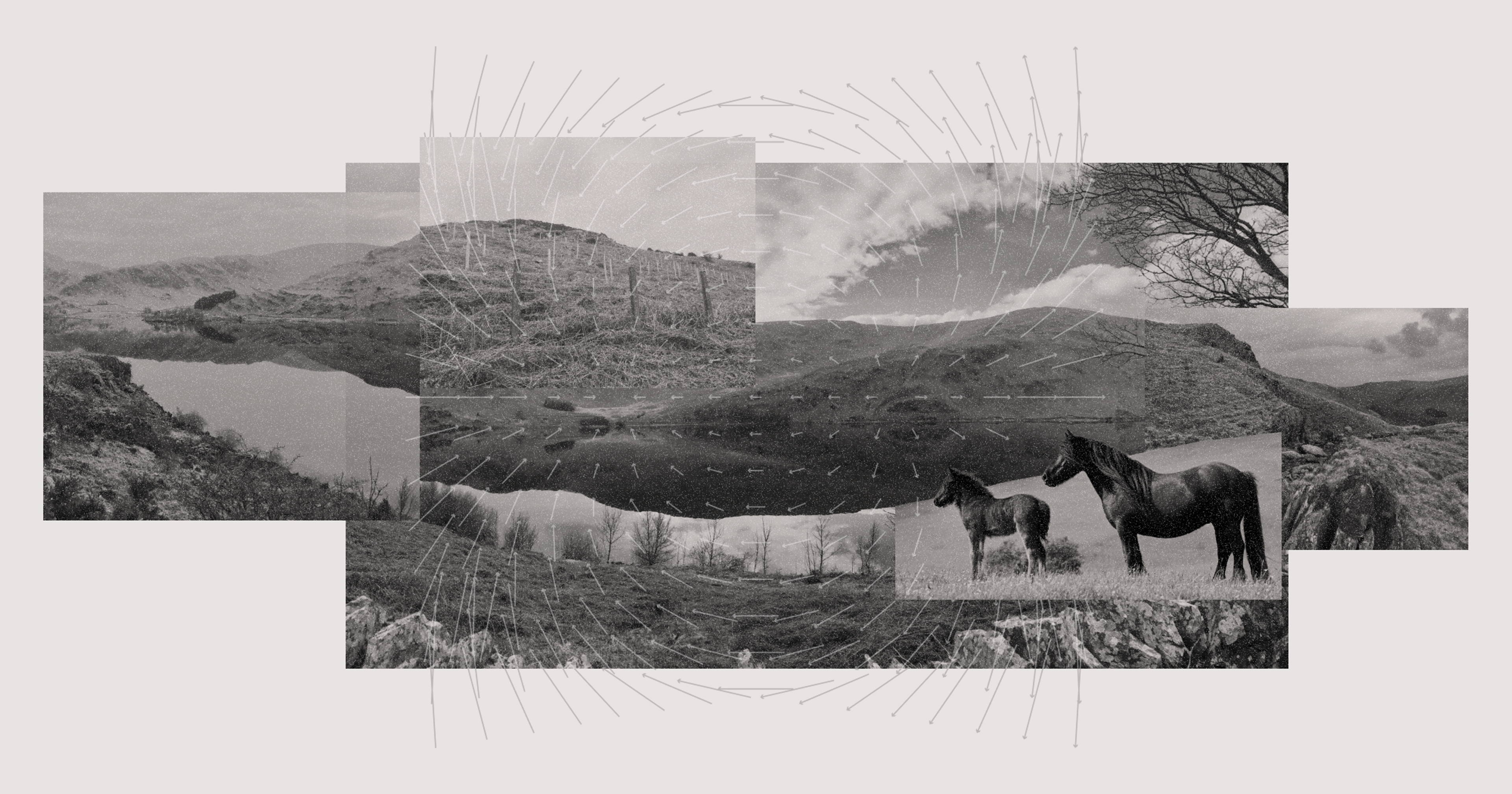A case study on the integration of animal farming and conservation may hold lessons for American farmers and policymakers.
The Lay of the Lakes
The eastern ramparts of England’s Lake District rise gradually and then suddenly, shifting from rolling hills to craggy uplands. At their confluence lies the Haweswater Reservoir, a crescent-shaped lake large enough to supply a quarter of northwest England’s water. All along its shores are signs that something unusual is afoot. Sheep, usually a staple of Lakeland valleys, are scarce, and saplings sprout from waterline to summit. Butterflies flit through fecund meadows, and birdsong burbles from the shrubbery.
The source of this mystery is Naddle Farm, a collection of barns and pastures near the base of the reservoir. Naddle is the headquarters of Wild Haweswater, an ecological restoration initiative that employs a combination of sustainable agriculture and landscape-scale conservation. The effort began in 2012, when the Royal Society for the Protection of Birds (RSPB) took on the tenancies of Naddle and Swindale Farms which, alongside their associated grazing land (commons), cover about 7,400 acres. The RSPB now works alongside United Utilities (UU) to produce high-quality livestock, enhance local ecosystems, and sequester carbon. Restoration efforts include tree-planting, bog rewetting, and the “re-wiggling” of Swindale Beck, the largest water feature on the site. The key to Wild Haweswater’s success in these projects has been its attunement to the needs of local ecosystems and communities. Its example shows that successful restoration projects need to be tailored both to their landscape and their political context.

The model of “agricultural wilding” employed at Haweswater has parallels in the US and across the UK. American examples include the National Audubon Society’s agricultural policy program — which focuses on the conservation of prairies and wetlands and the protection of marginal lands from intensive crop production — and the Nature Conservancy’s Regenerative Food Systems program. However, agricultural rewilding is particularly common in the UK, where ecological restoration often accompanies animal farming. Haweswater uses a mixture of traditional grazing practices and newer approaches such as agroforestry and the introduction of feral livestock. Restoration efforts in the US and elsewhere can learn from this model, which seeks to combine ecologically sound traditional practices with new techniques customized to suit the unique ecological and political context of the Lakes.
Agricultural rewilding is particularly common in the UK, where ecological restoration often accompanies animal farming.
“We use the term rewilding sparingly here,” said Lee Schofield, senior site manager of Wild Haweswater and author of Wild Fell, in an interview. “Our work is all about getting natural processes flowing again. It doesn’t have to involve reintroducing carnivores and certainly doesn’t involve booting anyone off the land. We’ve always been managing landscapes to meet human needs, and while our methods are different, our goal is to restore ecosystems while opening up new opportunities for people.”
The Haweswater Model
Haweswater is located in an upland ecosystem, which covers only 12% of England’s land but is estimated to contain 70% of the country’s drinking water, 25% of its woodland, 29% of its beef cows, and 44% of its breeding sheep. Uplands are crucial for both ecology and agriculture, and what happens on them cascades to the plains below. The RSPB manages 170 sites across the UK, many of which have an agricultural component. However, Haweswater is distinct because of its reliance on commonage — pasture grazed jointly by the flocks of multiple farmers. As a result, it must tailor its restoration efforts to a very different landscape and social context than comparable projects in the British lowlands or the US, which generally involve either a single owner or multiple properties, each with its own owner.
The example of Haweswater and other commonage conservation projects shows that buying into local communities rather than buying them out increases a project’s durability and reduces the likelihood of public backlash. This is borne out in many of the most successful restoration projects in the US, such as agricultural rewilding projects on the Great Plains that have used the return of bison to provide a cultural, environmental, and economic boost to tribal communities. What these success stories share with Haweswater is a commitment to finding methods rooted in local ecology and community.

Wild Haweswater operates in a politically charged environment where farming traditions are sacrosanct. Cumbrian shepherds sometimes talk about how the sheep breeds they herd date back to Viking times. In most farming communities, both in the UK and the US, agriculture is imprinted in local culture. This can make it difficult to implement policies, such as scaling back agriculture in marginal land, that make economic sense but run contrary to ingrained custom. This is especially true of the Lake District, where some traditionalists seek to preserve the land in a time capsule.
When a UNESCO committee visited the region in 2017, it described Haweswater as a “wart” on the face of the Lake District’s bid for World Heritage status because of its unconventional farming practices. Schofield says that working with local farmers is largely a matter of recognizing and accepting who is amenable to collaboration and who is not. “We need to work out who we can work with and who is in a different place. Some farmers are not happy with what we’re doing here, while others are excited about regenerative farming. The key is that farming up here has always been an ongoing evolution.”
In past decades, England’s farmers have achieved remarkable success in meeting the central demand of society: higher output. Since the 1970s, they have achieved a rise in productivity of more than 50%. However, this success has come at great environmental cost — the Lake District, like nearly all rural parts of the UK, is being degraded by current land-use practices. Seventy-seven percent of the protected sites in the Lake District are classified as in “unfavorable condition,” according to a conservative estimate from the government.
Wild Haweswater is making two main changes to its grazing operation. First, it is bringing limited numbers of belted Galloway cattle and feral ponies, which will break up bracken thickets and clear space in the understory. Second, it is decreasing headage. Naddle Farm had 3,500 breeding ewes at its peak in the late ‘90s, but the herd is now down to 300. Schofield argues that these reductions make economic and environmental sense. “Our plan is to reduce inputs and farm within the land’s carrying capacity,” he says. “We won’t bring in costly treatments, pesticides, feeds, or fertilizers. We’ll use what the grass and sun can freely provide. That will make the operation if not profitable, then at least much less loss-making.”
Financial Constraints
Haweswater is open about the fact that its livestock operation, like the vast majority of upland farms in the UK, would make a heavy loss without subsidies. Average yearly sales from 2013 to 2016, the period covered by its latest economic report, were £55,272 with associated costs of £217,403 per year. Government grants averaging £278,939 per year turned this into an annual profit of £95,808. The RSPB invests an additional £52,000 a year to cover the full costs. Meanwhile, UU provides capital grant funding for on-site infrastructure projects through their Sustainable Catchment Management Programme. This harsh reality helps explain why most rewilding projects across the UK — the Knepp Estate, Affric Highlands, Wild Ken Hill, WildEast, and Wild Ennerdale — have arisen through some permutation of private wealth, NGO support, and government backing.
From an economic standpoint, Haweswater and its peers have limited relevance to American farmers seeking to implement similar practices. Farmers who lack such institutional support can learn from the regenerative farming practices and focus on local issues at Haweswater, but they cannot look to it as a financial model. This outlook could change if federal and state governments create new incentives for regenerative farming, for instance through the 2023 Farm Bill, or if independent carbon credit schemes become more accessible and profitable to farmers.

Over the coming years, the Haweswater staff will keep reducing the size of the sheep flock and bring in more belted Galloways and fell ponies. Schofield also envisions diversifying into ecotourism by building a visitor center, science hub, and bunkhouse — though these projects will require funding from the RSPB or other sources. They have also examined carbon sequestration as a potential income stream. Some studies show that in relatively unproductive areas like the uplands, carbon storage and sequestration may be more profitable than grazing. Wild Haweswater already sequesters carbon through tree-planting and bog restoration and measures the resulting drawdown.
The catch is that as tenants of United Utilities, the carbon they sequester most likely belongs to the company. This would not be a problem on the vast majority of US farms, which are overwhelmingly privately owned, but it could complicate efforts to bring carbon credit schemes to public grazing lands in the West. Haweswater’s cross-analysis of potential diversification strategies shows that the methods that make economic, environmental, and political sense are dependent on local context. The main takeaway from Haweswater’s diversification efforts for farms outside the Lakes is that identifying which strategies are appropriate requires a close analysis of local conditions that may rule out approaches that would be lucrative elsewhere.
To date, Wild Haweswater and similar restoration projects have not demonstrated the capacity to operate unless a series of economic stars align. However, this is a watershed period for the economics of the Haweswater operation and British agriculture more broadly. In the wake of Brexit, the UK government is shifting from the EU’s Common Agricultural Policy (CAP), which paid farmers a “Basic Payment” for the amount of land under cultivation, to a new approach based on ecosystem services. The new Agricultural Land Management Scheme (SFI) will pay farmers to produce both food and public goods such as water quality, biodiversity, and climate change mitigation.
From 2021 to 2027, the government will phase out CAP-style direct payments. This approach has come under fire from some farmers, who argue that it unduly limits food production and threatens to outsource environmental harm to other parts of the world. Some studies suggest that new payments are unlikely to fully cover the shortfall left by the exit from CAP, and most farms cannot afford a significant reduction in subsidies. Although the new system is an opportunity for farms like Naddle and Swindale that already pursue ecosystem restoration, they could not afford even a slight drop in payments.
Lessons for the States
In the US, there is no near-term prospect for a comparable transformation of agricultural subsidies, though the 2023 Farm Bill could create new incentives and strengthen existing ones. There are multiple federal programs that encourage sustainable farming, such as the Agriculture and Food Research Initiative, the Conservation Reserve Program, and the Agricultural Conservation Easement Program. Each has its shortcomings. For instance, the Conservation Reserve Program, which pays farmers a yearly rate to remove “environmentally sensitive” cropland from production, has been hampered by high prices for agricultural commodities, as well as competition from a USDA insurance program called Pasture, Rangeland, Forage.
There is greater potential for reform at the state level. Examples include Colorado’s Soil Health Initiative and the Texas Department of Agriculture’s conservation division, which has worked to restore grasslands in Gulf Coast prairies and the Lower Rio Grande Valley, among other target areas. California, meanwhile, has created incentives for farmers to reduce their carbon emissions. These include its Healthy Soils Program, which helps farmers restore soil health by offering loans, grants, outreach, and education, and its Farmland Conservancy Program, which works to establish agricultural conservation easements and land improvement projects.

State initiatives are a vital tool for farmers seeking to grow food more sustainably. They often match federal grant dollars, helping to cover the cost of transitioning to new practices. However, they have two serious flaws. First, they are not large enough to engineer a large-scale shift to regenerative practices. Even in states with relatively robust sustainable farming initiatives, current support networks are too insubstantial to provide a comprehensive solution. When the California Energy Commission launched its Renewable Energy for Agriculture Program, which subsidizes the installation of renewable energy technologies on farms, program funding was exhausted within a few months. Second, the myriad of state, federal, and independent schemes is disjointed and convoluted.
Some state schemes have sought to address this problem. The Oklahoma Carbon Program combats fragmentation by overlapping existing conservation programs offered by state and federal agencies, including the USDA Natural Resources Conservation Service, to incentivize farmers to voluntarily sequester or avoid emissions. However, such efforts to expand and streamline incentives will have to go much farther to make sustainable farming convenient and financially feasible at scale.
This need for a larger, more integrated support network makes the changes currently underway in UK subsidy schemes relevant to the US. Both the federal and state governments can learn from how the UK’s new system affects agricultural output and ecosystem health. Its success or failure will be especially instructive given that the UK and the US currently rank similarly on metrics of food sustainability.
Another aspect of the UK’s Environmental Land Management (ELM) scheme that Americans can learn from now is the need for a tailored, localized approach to ecosystem restoration. Some of the most successful pilot schemes in the rollout of the ELM system, such as in the Yorkshire Dales, Dartmoor, and Cranborne Chase, have been designed to give farmers flexibility in how they provide ecosystem services. Meanwhile, the success of Wild Haweswater in restoring local ecosystems has depended on techniques specific to the British uplands, such as re-wetting moors, ending “muirburn” of heather, and extending treelines to higher altitudes. At the same time, strategies such as reforestation, regenerative grazing, and soil carbon sequestration, are widely applicable. They just take a somewhat different form in Haweswater’s unique ecology.
A Difference in Goals
Many of the techniques deployed at Haweswater are used in the US, but what about the goals of the project? Is there something distinctly British about its model of ecosystem restoration? Part of the difference lies in the UK’s population density — 700 per square mile versus just over 90 in the US — which precludes “wilderness” of the kind found in North America. Since over three quarters of the UK is farmland, it may be a better analog for the American Midwest or California’s Central Valley than for less intensively farmed regions. Europe may be a more helpful model for the northeast, as both regions have experienced large-scale farmland abandonment, which is still uncommon in the UK.
Britain’s lack of extensive open land means that its protected areas must cater not just to nature, but also to farming and rural industries. Haweswater shows the importance of finding a more effective equilibrium between human needs and ecological integrity. This is an important lesson for the US, where there is a tendency to focus on preserving tracts of wilderness rather than thinking about how to treat the land we already occupy better.
The Haweswater model is a product of economic, cultural, and political circumstances unique to the Lakes, but its successful adaptation to these conditions can inform projects in very different landscapes and political contexts. While Haweswater does not present a viable financial model for US farmers, it offers a lesson in the importance of tailoring ecological restoration to local communities and ecosystems. In addition, it and the UK agricultural system more broadly can inform US efforts to expand and streamline government support for regenerative agriculture and, in doing so, bring human needs into closer alignment with ecosystem health.
Haweswater is in many ways a landscape of ghosts. The RSPB first arrived in the valley in 1969 to protect Britain’s last breeding pair of golden eagles, the most recent of many enigmatic species — lynx, wolves, moose — to disappear from the site. Some of these “holes in the map,” as Schofield calls them, such as pine martens, beavers, and eagles, may yet return, but their homecoming will not require humans and their livestock to become ghosts in turn. If the Wild Haweswater succeeds in its mission, they will find a landscape that belongs just as much to them as to the people who farm it in accordance with its unique needs and qualities.







